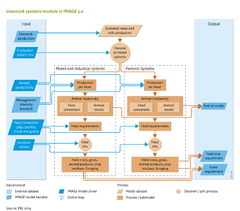Livestock systems/Description: Difference between revisions
Jump to navigation
Jump to search
m (Text replace - "|Status=On hold" to "") |
No edit summary |
||
| Line 1: | Line 1: | ||
{{ComponentDescriptionTemplate | {{ComponentDescriptionTemplate | ||
|Reference=Seré and Steinfeld, 1996; | |Reference=Seré and Steinfeld, 1996; | ||
|Description=For each world region, IMAGE distinguishes two livestock production systems, namely pastoral systems and mixed/industrial systems, on the basis of [[FAO]] studies ([[Seré and Steinfeld, 1996]]). In general, pastoral systems are dominated by extensive ruminant production systems. Mixed and industrial systems are more intensive than pastoral ones, and animal husbandry comprises grazing ruminants and monogastrics. For years up to the present, the distribution of livestock production over the two systems, for each IMAGE region, is constructed from historical data, whereas for future years, this depends on the scenario selected. | |Description=For each world region, IMAGE distinguishes two livestock production systems, namely pastoral systems and mixed/industrial systems, on the basis of [[FAO]] studies ([[Seré and Steinfeld, 1996]]). In general, pastoral systems are dominated by extensive ruminant production systems. Mixed and industrial systems are more intensive than pastoral ones, and animal husbandry comprises grazing ruminants and monogastrics. For years up to the present, the distribution of livestock production over the two systems, for each IMAGE region, is constructed from historical data, whereas for future years, this depends on the scenario selected. | ||
| Line 7: | Line 6: | ||
Animal stocks per region, for the categories beef cattle, pigs, and sheep and goats, is obtained from production and carcass weight (CW) and off-take rate (OR): | Animal stocks per region, for the categories beef cattle, pigs, and sheep and goats, is obtained from production and carcass weight (CW) and off-take rate (OR): | ||
{{FormulaAndTableTemplate|Formula2_LS}} | {{FormulaAndTableTemplate|Formula2_LS}} | ||
Historical data on milk production per cow, off-take rate, and carcass weight are obtained from statistics, and values for future years will depend on the scenario selected. | |||
Energy requirements: For dairy cattle, the energy requirements are calculated for maintenance (based on body weight), feeding (based on the proportion of grass in feed rations), lactation (based on milk production per cow) and pregnancy (based on the number of calves per year). The amount of feed dry matter is calculated on the basis of the proportion of digestible energy in the total energy intake, and the energy content of biomass. | |||
Energy requirements for cattle are based on animal activity and production, and for pigs, poultry, sheep and goats on Feed Conversion Ratios ([[HasAcronym::FCR]]). This is the amount of feed (kg dry matter) required to produce one kilogram of milk or meat. The FCR values are based on historical data and values for future years will depend on the scenario selected. | |||
# grass, including hay and grass silage; | Cropland and grassland required: ([[Agricultural systems]]) are calculated on the basis of feed crop and grass requirements, which are calculated from total feed requirement and diet composition (feed rations). | ||
#food crops and by-products | Composition of animal feed: IMAGE distinguishes five feed categories: | ||
# crop residues | # grass, including hay and grass silage; | ||
# animal products; | # food crops and processing by-products; | ||
# foraging | # crop residues in the field after harvesting, and fodder crops; | ||
# animal products; | |||
The required feed crop production is calculated from feed rations, and this information is | # foraging including roadside grazing, scavenging household waste, and feedstuffs from backyard farming. | ||
In pastoral ruminant production systems, the feed is almost entirely grass except in developing regions where foraging constitutes a larger but variable proportion of the total feed. Pigs and poultry are fed on food crops and by-products, crop residues and fodder. Since these animals are mainly farmed in mixed systems, the contribution of food crops and residues to the total feed in these systems is much higher than in pastoral systems. | |||
The required feed crop production per animal is calculated from feed rations, and this information is incorporated into the Agricultural Economy Demand model ([[Agricultural Economy and forestry]]). The proportion of grass in feed rations determines total grass consumption, which is used to compute the grassland area per world region, based on grazing intensity ([[Agricultural Economy and forestry]] and [[Agricultural systems]]). | |||
Scenario definition: A scenario includes assumptions on milk production per animal for dairy cattle, carcass weight and off-take rate for beef cattle, pigs, poultry, sheep and goats, and feed conversion rates (FCR) for pigs, poultry, sheep and goats. The changes in these parameters are generally based on the storyline of the scenario, and on the economic growth scenario. | |||
}} | }} | ||
Revision as of 15:45, 10 February 2014
Parts of Livestock systems/Description
| Component is implemented in: |
| Components: |
| Related IMAGE components |
| Projects/Applications |
|
| Models/Databases |
| Key publications |
| References |
